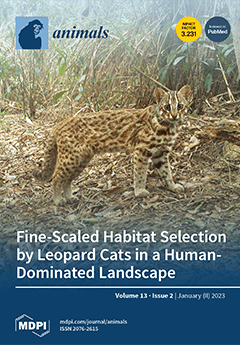This study aimed to investigate the spatially and temporally expressed patterns and biological characteristics of
TSSK1B in male yaks and explore the potential correlation between
TSSK1B and male sterility of the yak hybrid offspring (termed cattle–yak). First, the coding sequence (CDS) of
TSSK1B was cloned by RT-PCR, and bioinformatics analysis was conducted with relevant software. Quantitative real-time PCR (RT-qPCR) was employed to detect the expression profile of
TSSK1B in various tissues of male adult yaks, the spatiotemporal expression of
TSSK1B in different stages of yak testes, and the differential expression of
TSSK1B between yak and cattle–yak testes. The cellular localization of
TSSK1B was determined by immunohistochemistry (IHC). Furthermore, the methylation status of the
TSSK1B promoter region was analyzed by bisulfite-sequencing PCR (BSP). The results showed that
TSSK1B was 1235 bp long, including 1104 bp of the CDS region, which encoded 367 amino acids. It was a conserved gene sharing the highest homology with
Bos mutus (99.67%). In addition, the bioinformatics analysis revealed that TSSK1B was an unstable hydrophilic protein mainly containing the alpha helix of 34.06% and a random coil of 44.41%, with a transmembrane structure of 29 amino acids long. The RT-qPCR results demonstrated that
TSSK1B was specifically expressed in yak testes compared with that in other tissues and especially highly expressed in adult yak testes. On the contrary,
TSSK1B was hardly expressed in the testis of adult cattle–yak. IHC confirmed that
TSSK1B protein was more strongly expressed in the testes of adult yaks than in their fetal and juvenile counterparts. Interestingly, nearly no expression was observed in the testes of cattle–yak compared with the corresponding testes of yak. Bisulfite-sequencing PCR (BSP) revealed that the methylated CpG sites in the
TSSK1B promoter region of cattle–yak was significantly higher than that in the yak. Taken together, this study revealed that
TSSK1B was specifically expressed in yak testes and highly expressed upon sexual maturity. Moreover, the rare expression in cattle–yak may be related to the hypermethylation of the promoter region, thereby providing a basis for further studies on the regulatory mechanism of
TSSK1B in male cattle–yak sterility.
Full article






